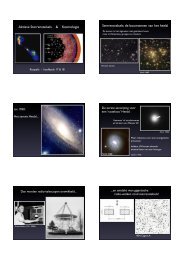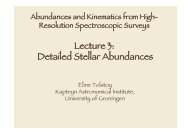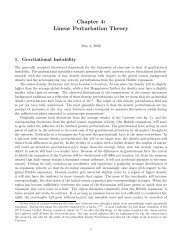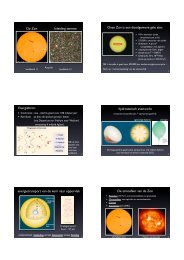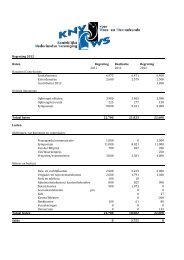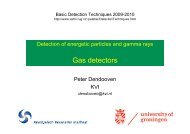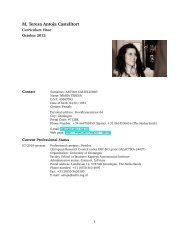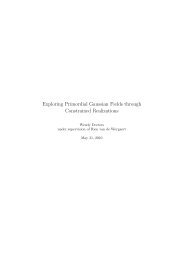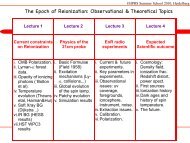college10
college10
college10
You also want an ePaper? Increase the reach of your titles
YUMPU automatically turns print PDFs into web optimized ePapers that Google loves.
(Classic) IIR filter design:<br />
Basic Design Approaches<br />
1. Convert the digital filter specifications into an analog prototype lowpass filter<br />
specifications<br />
2. Determine the analog lowpass filter transfer function |H(Ω)|<br />
3. Transform |H(Ω)| into the desired digital transfer function H(z)<br />
• Analog approximation techniques are highly advanced<br />
• They usually yield closed-form solutions<br />
• Extensive tables are available for analog filter design<br />
(Chapter 9)<br />
• Many applications require digital simulation of analog systems<br />
FIR filter design is based on a direct approximation of the specified<br />
magnitude response, with the often added requirement that the phase<br />
be linear (or sometimes, even minimum)<br />
The design of an FIR filter of order M may be accomplished by finding either the<br />
length-(M+1) impulse response samples of h[n] or the (N+1) samples of its<br />
frequency response H(ω) (Chapter 10)<br />
Digital Signal Processing, © 2007 Robi Polikar, Rowan University
FIR Filter Design<br />
Let’s start with the ideal lowpass filter<br />
We know that there are two problems with this filter: infinitely long, and it is non-causal<br />
H LP<br />
( ω)<br />
⎪⎧<br />
1, 0 ≤ ω ≤ ωc<br />
= ⎨<br />
⎪⎩ 0, ωc<br />
≤ ω ≤ π<br />
h<br />
LP[<br />
n]<br />
h LP [n]<br />
c<br />
1<br />
= ∫ 1⋅e<br />
2π<br />
=<br />
ω<br />
−ω<br />
( ω n)<br />
sin<br />
πn<br />
c<br />
c<br />
jωn<br />
dω<br />
, − ∞ < n < ∞<br />
How can we overcome<br />
these two problems?<br />
Digital Signal Processing, © 2007 Robi Polikar, Rowan University
FIR Filter Design<br />
0 20 40 80 100 120 140 160 180 200<br />
Digital Signal Processing, © 2007 Robi Polikar, Rowan University
FIR Filter Design<br />
This is the basic, straightforward approach to FIR filter design:<br />
Start with an ideal filter that meets the design criteria, say a filter H(ω)<br />
Take the inverse DTFT of this H(ω) to obtain h[n].<br />
• This h[n] will be double infinitely long, and non-causal unrealizable<br />
Truncate using a window, say a rectangle, so that M+1 coefficients of h[n] are<br />
retained, and all the others are discarded.<br />
• We now have a finite length (order M) filter, h t [n], however, it is still non-causal<br />
Shift the truncated h[n] to the right (i.e., delay) by M/2 samples, so that the first<br />
sample now occurs at n=0.<br />
• The resulting impulse response, h t [n-M/2] is a causal, stable, FIR filter, which has an<br />
almost identical magnitude response and a phase factor or e -jM/2 compared to the<br />
original filter, due to delay introduced.<br />
Digital Signal Processing, © 2007 Robi Polikar, Rowan University
WINDOWING: zero<br />
coefficients outside<br />
–M/2 ≤ n ≤ M/2 and<br />
a shift to the right<br />
yields finite series<br />
with length M+1<br />
h<br />
LP<br />
[ n]<br />
⎧sin( ωc<br />
( n−<br />
M / 2)) M<br />
, 0 ≤ n ≤ M,<br />
n ≠<br />
⎪ π ( n−<br />
M /2) 2<br />
= ⎨<br />
⎪ ωc<br />
M<br />
,<br />
n =<br />
⎪⎩ π<br />
2
h<br />
HP<br />
[ n]<br />
⎧ sin( ωcn) − , n > 0<br />
= ⎪<br />
⎨ π n<br />
⎪ ωc<br />
1- , n 0<br />
⎪⎩ π<br />
=
FIR BPF/BSF Design<br />
H BP (e jω )<br />
H LP (e j ω )<br />
H LP (e j ω )<br />
–1<br />
1<br />
= -<br />
1<br />
−π<br />
–ωc2 –ωc1 ωc1 ωc2<br />
π<br />
ω<br />
−π<br />
–ωc<br />
0 ωc<br />
ω c = ω c2<br />
π<br />
ω<br />
−π<br />
–ωc<br />
0 ωc<br />
ω c = ω c1<br />
π<br />
ω<br />
H<br />
BP<br />
( ω)<br />
=<br />
H<br />
LP<br />
( ω)<br />
h<br />
ω = ω<br />
c<br />
BP[<br />
n]<br />
c2<br />
− H<br />
⎧sin<br />
⎪<br />
= ⎨<br />
⎪ωc2<br />
⎪<br />
⎩ π<br />
LP<br />
( ω)<br />
ω = ω<br />
c<br />
c1<br />
( ωc<br />
( n − M / 2)<br />
)<br />
2<br />
π ( n − M / 2)<br />
ωc<br />
1<br />
−<br />
π<br />
, n =<br />
−<br />
M<br />
2<br />
sin<br />
h<br />
BP<br />
[ n]<br />
= h<br />
LP<br />
( ωc<br />
( n − M / 2)<br />
)<br />
1<br />
π ( n − M / 2)<br />
,<br />
[ n]<br />
c<br />
c2<br />
− h<br />
[ n]<br />
ω = ω LP ω = ω<br />
0 < n < M , n ≠<br />
M<br />
2<br />
c<br />
c1<br />
Similarly,<br />
H<br />
BS<br />
( ω)<br />
= 1−<br />
H ( ω)<br />
h [ n]<br />
= δ[<br />
n]<br />
− h [ n]<br />
BP<br />
Digital Signal Processing, © 2007 Robi Polikar, Rowan University<br />
BS<br />
BP
However…<br />
?<br />
What<br />
happened…?<br />
Digital Signal Processing, © 2007 Robi Polikar, Rowan University
Gibbs Phenomenon<br />
Truncating the impulse response of an ideal filter to obtain a realizable<br />
filter, creates oscillatory behavior in the frequency domain.<br />
The Gibbs Phenomenon<br />
We observe the following:<br />
As M↑, the number of ripples ↑<br />
however, ripple widths ↓<br />
The height of the largest ripples<br />
remain constant, regardless of the<br />
filter length<br />
As M↑, the height of all other<br />
ripples ↓<br />
The main lobe gets narrower as<br />
M↑, that is, the drop-off becomes<br />
sharper<br />
Similar oscillatory behavior can be<br />
seen in all types of truncated filters<br />
Magnitude<br />
1.5<br />
1<br />
0.5<br />
0<br />
0 0.2 0.4 0.6 0.8 1<br />
ω/π<br />
Main lobe<br />
M = 20<br />
M = 60<br />
Side lobes<br />
Digital Signal Processing, © 2007 Robi Polikar, Rowan University
Gibbs Phenomenon<br />
Why is this happening?<br />
The Gibbs phenomenon is simply an artifact of the windowing<br />
operation.<br />
Multiplying the ideal filter’s impulse response with a rectangular window function<br />
is equivalent to convolving the underlying frequency response with a sinc<br />
h[ n] = h [ n] ⋅w[ n] ⇔ H ( ω) = H ( ω)* W( ω)<br />
t d t d<br />
Truncated filter<br />
impulse response<br />
Desired filter<br />
impulse response<br />
Windowing<br />
function<br />
However, we want H t (ω) to be as close as possible to H d (ω), which can only be<br />
possible if the W(ω)=δ(ω) w[n]=1, an infinite window.<br />
• We have conflicting requirements: On one hand, we want a narrow window, so that we<br />
have a short filter; on the other hand, we want the truncated filter as closely match as<br />
possible ideal filter’s frequency response, which in turn requires an infinitely long<br />
window!<br />
This convolution results in the oscillations, particularly dominant at the edges.<br />
Digital Signal Processing, © 2007 Robi Polikar, Rowan University
Gibbs Phenomenon<br />
H d : Ideal filter<br />
frequency response<br />
Ψ: Rectangular window<br />
frequency response<br />
H t : Truncated filter’s<br />
frequency response<br />
Digital Signal Processing, © 2007 Robi Polikar, Rowan University
Window_LPF.m<br />
% FIR Lowpass filter<br />
M=input('Enter the order of filter:');<br />
wc=input('Enter the cutoff frequency in terms of radians:');<br />
n=0:M;<br />
h_LP=sin(wc*(n-M/2))./(pi*(n-M/2));<br />
h_LP(ceil(M/2+1))=wc/pi;<br />
subplot(211)<br />
stem(n, h_LP)<br />
axis([0 M min(h_LP) max(h_LP)])<br />
title(['Impulse response of the ',num2str(M),…<br />
'th order filter']);<br />
subplot(212)<br />
H_LP=fft(h_LP, 1024);<br />
w=linspace(-pi, pi, 1024);<br />
plot(w/pi, abs(fftshift(H_LP)))<br />
title(['Frequency response of the windowed ', …<br />
num2str(M), 'th order filter']);<br />
grid<br />
axis([-1 1 0 max(abs(H_LP))])<br />
Gibbs Phenomenon<br />
Demo<br />
( ωc<br />
( − ))<br />
π ( n−<br />
M )<br />
⎧sin n M / 2 M<br />
,0 ≤ n≤ M , n ≠<br />
⎪<br />
/2 2<br />
h LP [ n ] = ⎨<br />
⎪ ωc<br />
M<br />
⎪ , n =<br />
⎩ π 2<br />
Digital Signal Processing, © 2007 Robi Polikar, Rowan University
Effect of Filter Length<br />
Transition band / main lobe width<br />
Stopband attenuation<br />
In dB<br />
Digital Signal Processing, © 2007 Robi Polikar, Rowan University
Here’s what we want:<br />
Quick drop off Narrow transition band<br />
• Narrow main lobe<br />
Digital Signal Processing, © 2007 Robi Polikar, Rowan University<br />
FIR Filter Design<br />
Using Windows<br />
Conflicting requirements<br />
• Increased stopband attenuation<br />
Reduce the height of the side-lobe which causes the ripples<br />
Reduce Gibb’s phenomenon (ringing effects, all ripples)<br />
Minimize the order of the filter.<br />
Gibb’s phenomenon can be reduced (but not eliminated) by using a<br />
smoother window that gently tapers off to zero, rather than the brick<br />
wall behavior of the rectangular filter.<br />
Several window functions are available, which usually trade-off main-lobe width<br />
and stopband attenuation.<br />
• Rectangular window has the narrowest main-lobe width, but poor side-lobe<br />
attenuation.<br />
• Tapered window causes the height of the sidelobes to diminish, with a corresponding<br />
increase in the main lobe width resulting in a wider transition at the cutoff frequency.
Commonly Used Windows<br />
0
Commonly Used Windows<br />
Narrow<br />
Wide main (poor) lobe<br />
main lobe<br />
Very wide (poor)<br />
main lobe<br />
Poor side lobe<br />
Good attenuation side lobe<br />
attenuation<br />
Widest<br />
Wide<br />
(poorest)<br />
(poor)<br />
main<br />
main<br />
lobe<br />
lobe<br />
Very good side lobe<br />
attenuation<br />
Good side lobe<br />
Excellent attenuation side lobe<br />
attenuation<br />
Digital Signal Processing, © 2007 Robi Polikar, Rowan University
Compare_windows.m<br />
Comparing Windows<br />
1.5<br />
1<br />
0.8<br />
1<br />
0.6<br />
0.4<br />
0.5<br />
0.2<br />
1.5<br />
1<br />
0.5<br />
LPF design with different window types. Filter order: 20<br />
LPF design with different window types. Filter order: 20<br />
LPF design with different window types. Filter order: 44 Cutoff frequency: 0.4π radians<br />
Rectangular Rectangular<br />
Rectangular<br />
Bartlett<br />
Bartlett Bartlett<br />
Blackman<br />
Blackman<br />
Hamming<br />
Hamming<br />
Hann<br />
Hann<br />
0<br />
0<br />
0 0 0.1 0.2 0.3 0.4 0.5 0.6 0.7 0.8 0.9 1<br />
00.2 0.1 0.3 0.2 0.30.4 0.4 0.5 0.5 0.6 0.6 0.7 0.7 0.8 0.90.8<br />
1<br />
Normalized frequency, ω/π<br />
Normalized frequency, ω/π<br />
LPF LPF design design with with different different window window types - types Gain plots - Gain (in plots dB)<br />
50 50 LPF design with different window types - Gain plots<br />
0<br />
0<br />
-50<br />
-50<br />
dB<br />
0<br />
-50<br />
-100<br />
-100<br />
-100<br />
-150<br />
-200<br />
0 0.1 0.2 0.3 0.4 0.5 0.6 0.7 0.8 0.9 1<br />
-150<br />
0 0.1 0.2 0.3<br />
Normalized<br />
0.4 0.5<br />
frequency,<br />
0.6 ω/π 0.7 0.8 0.9 1<br />
0.35 0.4 0.45 0.5 0.55 0.6 0.65 0.7 0.75 0.8<br />
Digital Signal Processing, © 2007 Robi Polikar, Rowan University<br />
Normalized frequency, ω/π<br />
Normalized frequency, ω/π
Fixed Window Functions<br />
All windows shown so far are fixed window functions<br />
Magnitude spectrum of each window characterized by a main lobe centered at<br />
ω = 0 followed by a series of sidelobes with decreasing amplitudes<br />
Parameters predicting the performance of a window in filter design are:<br />
• Main lobe width (Δ ML<br />
) : the distance b/w nearest zero-crossings on both sides<br />
or transition bandwidth (Δω=ω s<br />
– ω p<br />
)<br />
• Relative sidelobe level (A sl<br />
): difference in dB between the amp. of the largest sidelobe and the main<br />
lobe (or sidelobe attenuation (α s<br />
) )<br />
For a given window, both<br />
parameters all completely<br />
determined once the filter<br />
order M is set.<br />
H tr<br />
(ω)<br />
α s (dB)<br />
H des<br />
(ω)<br />
Δω < Δ ML<br />
Δ ML<br />
Digital Signal Processing, © 2007 Robi Polikar, Rowan University
Fixed Window Functions<br />
Min. stopband Transition<br />
Attenuation Bandwidth Δω<br />
How to design:<br />
Set ωc<br />
= ( ωp<br />
+ ωs ) / 2<br />
Choose window type based on the specified sidelobe attenuation (A sl ) or minimum<br />
stopband attenuation (α s )<br />
Choose M according to the transition band width (Δω) and/or mainlobe width<br />
(Δ ML ). Note that this is the only parameter that can be adjusted for fixed window<br />
functions. Once a window type and M is selected, so are A sl , α s , and Δ ML<br />
• Ripple amplitudes cannot be custom designed.<br />
Adjustable windows have a parameter that can be varied to trade-off between<br />
main-lobe width and side-lobe attenuation.<br />
Digital Signal Processing, © 2007 Robi Polikar, Rowan University<br />
20.9 0.92π/(M/2)<br />
See book See book<br />
43.9 3.11 π/(M/2)<br />
54.5 3.32 π/(M/2)<br />
75.3 5.56 π/(M/2)
Kaiser Window<br />
The most popular adjustable window<br />
⎧ n − M 2 2 ⎫<br />
I0⎨β<br />
1−<br />
( ) ⎬<br />
M<br />
w n =<br />
⎩<br />
2<br />
[ ]<br />
⎭<br />
, 0 ≤<br />
I ( β )<br />
0<br />
n ≤<br />
M<br />
where β is an adjustable parameter to trade-off between the main lobe<br />
width and sidelobe attenuation, and I 0 {x} is the modified zeroth-order<br />
Bessel function of the first kind:<br />
In practice, this infinite series can be computed for a finite number of terms for a<br />
desired accuracy. In general, 20 terms is adequate.<br />
Digital Signal Processing, © 2007 Robi Polikar, Rowan University<br />
I<br />
0<br />
I<br />
0<br />
( x)<br />
= 1+<br />
( x)<br />
≅ 1+<br />
∑ ∞<br />
k = 1<br />
∑<br />
k<br />
⎡<br />
⎢<br />
⎢⎣<br />
( x 2)<br />
k!<br />
( x 2)<br />
k<br />
⎡<br />
= ⎥ ⎥ ⎤<br />
⎢<br />
1⎢⎣<br />
k!<br />
⎦<br />
20<br />
k<br />
2<br />
⎤<br />
⎥ ⎥ ⎦<br />
2
FIR Design Using<br />
Kaiser Window<br />
Given the following:<br />
ω p<br />
- passband edge frequency and ω s<br />
- stopband edge frequency<br />
δ p<br />
- peak ripple value in the passband and δ s<br />
- peak ripple value in the stopband<br />
Calculate:<br />
α<br />
1. Minimum ripple in dB: s = − 20log10(<br />
δs<br />
) or − 20log10<br />
min δs,<br />
δ<br />
2. Normalized transition bandwidth: Δω<br />
= ω s −ω p<br />
3. Window parameters:<br />
⎧⎪<br />
( α<br />
s )<br />
0.4<br />
( ) ( )<br />
( { })<br />
0.1102 − 8.7 , α<br />
s<br />
> 50dB<br />
β = ⎨0.5842 α<br />
s<br />
− 21 + 0.07886 α<br />
s<br />
−21 , 21≤α<br />
s<br />
≤50dB<br />
0, α<br />
s<br />
≤21dB<br />
⎪⎩<br />
p<br />
4. Filter length, M+1:<br />
M<br />
⎧αs<br />
− 7.95<br />
⎪ + 1,<br />
2.285Δω<br />
+ 1 = ⎨<br />
⎪5.79<br />
,<br />
⎩ Δω<br />
α<br />
α<br />
s<br />
s<br />
> 21<br />
< 21<br />
Design specs for Kaiser window in<br />
your book is different. This one, while<br />
may seem more complicated is<br />
actually easier to follow.<br />
5. Determine the corresponding Kaiser window<br />
6. Obtain the filter by multipling<br />
the ideal filter h I<br />
[n] with w[n]<br />
⎧ n − M 2 2 ⎫<br />
I0⎨β<br />
1−<br />
( ) ⎬<br />
M<br />
w n =<br />
⎩<br />
2<br />
[ ]<br />
⎭<br />
, 0 ≤ n ≤ M<br />
I ( β )<br />
0<br />
Digital Signal Processing, © 2007 Robi Polikar, Rowan University
Design an FIR filter with the following characteristics:<br />
ω p =0.3π ω s = 0.5π, δ s = δ p =0.01 α=40dB, Δω=0.2π<br />
β =<br />
0.4<br />
β = 0.5842( α<br />
s<br />
− 21) + 0.07886( α<br />
s<br />
− 21), 21 ≤ α<br />
s<br />
< 50<br />
0.5842(19)<br />
0.4<br />
+ 0.07886×<br />
19 =<br />
32.05<br />
M + 1 =<br />
+ 1 = 23.2886 ≈ 24<br />
2.285(0.2π<br />
)<br />
w[ n]<br />
= kaiser( M + 1, β ) ( from matlab)<br />
3.3953<br />
Example<br />
h<br />
LP[<br />
n]<br />
⎧sin<br />
⎪ π<br />
= ⎨<br />
⎪ωc<br />
,<br />
⎪⎩<br />
π<br />
h<br />
t<br />
( ωc( n − M / 2)<br />
)<br />
( n − M / 2)<br />
n =<br />
M<br />
2<br />
, 0 < n < M , n ≠<br />
M<br />
2<br />
h<br />
LP[<br />
n]<br />
[ n]<br />
= h [ n]<br />
⋅ w[<br />
n],<br />
−12<br />
≤ n ≤12<br />
LP<br />
=<br />
⎧sin<br />
⎪<br />
⎨<br />
⎪<br />
⎩0.4,<br />
( 0.4π<br />
( n −12)<br />
)<br />
π ( n −12)<br />
n = 12<br />
,<br />
0 <<br />
n <<br />
23,<br />
n<br />
≠ 12<br />
Digital Signal Processing, © 2007 Robi Polikar, Rowan University
Complete Cycle for FIR Filter<br />
Design using Windows<br />
Depending on your specs, determine what kind of window you would<br />
like to use.<br />
For all window types, except Kaiser, once you choose the window, the only other<br />
parameter to choose is filter length M.<br />
• For Kaiser window, determine M and beta, based on the specs using the given<br />
expressions.<br />
Compute the window coefficients w[n] for the chosen window.<br />
Compute filter coefficients (taps)<br />
Determine the ideal impulse response h I [n] from the given equations for the type<br />
of magnitude response you need (lowpass, highpass, etc.)<br />
Multiply window and ideal filter coefficients to obtain the realizable filter<br />
coefficients (also called taps or weights): h[n]=h I [n].w[n]<br />
Convolve your signal with the new filter coefficients y[n]=x[n]*h[n].<br />
Demo: FIR_window.m<br />
Digital Signal Processing, © 2007 Robi Polikar, Rowan University
In Matlab<br />
The following functions create N-point windows for the<br />
corresponding functions:<br />
rectwin(N)<br />
hamming(N)<br />
hanning(N)<br />
Try this: h=hamming(40); [H w]=freqz(h,1, 1024); plot(w, abs(H))<br />
Compare for various windows. Also plot gain in dB<br />
The function window window design and analysis tool provides a<br />
GUI to custom design several window functions.<br />
The function fdatool filter design and analysis tool provides a<br />
GUI to custom design several types of filters from the given specs.<br />
The function sptool signal processing tool, provides a GUI to<br />
custom design, view and apply to custom created signals. It also<br />
provides a GUI for spectral analysis.<br />
Digital Signal Processing, © 2007 Robi Polikar, Rowan University<br />
bartlett(N)<br />
kaiser(N, beta)<br />
blackman(N)
Window Design &<br />
Analysis Tool<br />
>> window<br />
Digital Signal Processing, © 2007 Robi Polikar, Rowan University
Filter Design &<br />
Analysis Tool<br />
Digital Signal Processing, © 2007 Robi Polikar, Rowan University
In Matlab: fir1<br />
fir1 FIR filter design using the window method.<br />
b = fir1(N,Wn) designs an N'th order lowpass FIR digital filter and returns the filter coefficients in length N+1<br />
vector B. The cut-off frequency Wn must be between 0 < Wn < 1.0, with 1.0 corresponding to half the sample<br />
rate. The filter B is real and has linear phase. The normalized gain of the filter at Wn is -6 dB.<br />
b = fir1(N,Wn,'high') designs an N'th order highpass filter. You can also use B = fir1(N,Wn,'low') to design a<br />
lowpass filter.<br />
If Wn is a two-element vector, Wn = [W1 W2], FIR1 returns an order N bandpass filter with passband W1 < W <<br />
W2. You can also specify b = fir1(N,Wn,'bandpass'). If Wn = [W1 W2], b = fir1(N,Wn,'stop') will design a<br />
bandstop filter.<br />
If Wn is a multi-element vector, Wn = [W1 W2 W3 W4 W5 ... WN], FIR1 returns an order N multiband filter with<br />
bands 0 < W < W1, W1 < W < W2, ..., WN < W < 1.<br />
b = fir1(N,Wn,'DC-1') makes the first band a passband.<br />
b = fir1(N,Wn,'DC-0') makes the first band a stopband.<br />
b = fir1(N,Wn,WIN) designs an N-th order FIR filter using the N+1 length vector WIN to window the impulse<br />
response. If empty or omitted, FIR1 uses a Hamming window of length N+1. For a complete list of available<br />
windows, see the help for the WINDOW function. If using a Kaiser window, use the following<br />
b = fir1(N,Wn,kaiser(n+1,beta))<br />
Digital Signal Processing, © 2007 Robi Polikar, Rowan University



